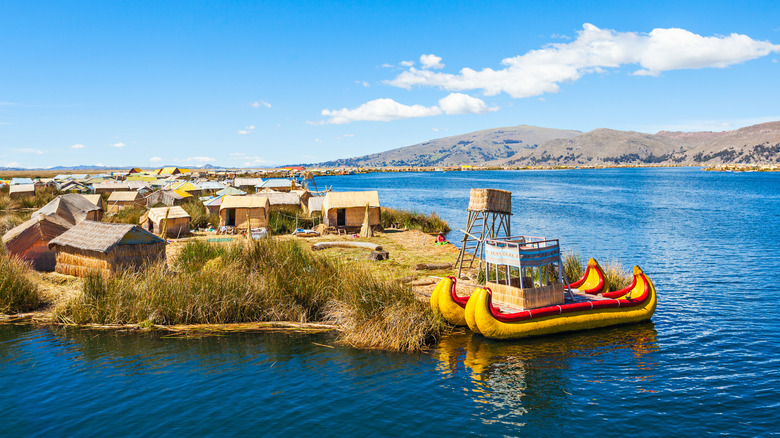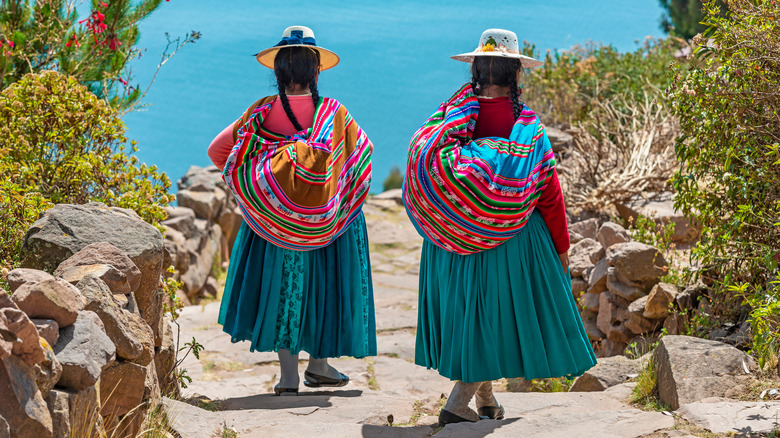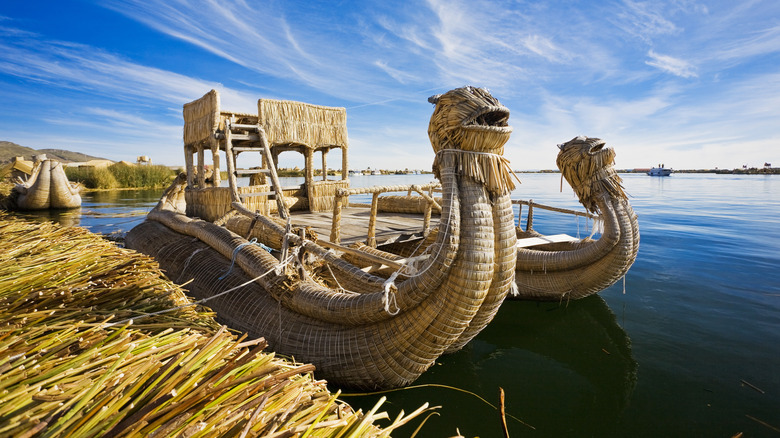This South American Destination Is An Often Overlooked Lakeside Getaway
South America is home to countless natural and man-made wonders. While many tourists head to the Amazon Basin for the Incan sanctuary of Machu Picchu, there's another marvel in Southern Peru where time stands still: Lake Titicaca. Standing 12,500 feet above sea level, this body of water is the largest freshwater lake on the continent and the highest navigable lake on the planet. Even more fascinating, there's an indigenous group who has lived there on man-made islands for the past 500 years.
This stroke of genius emerged in the 1400s when tensions mounted in the nearby Incan empire. The Uros people fled their villages on land and constructed artificial islands made of reeds to live on the lake in peace. Today, there are more than 120 islands strung together by rope and anchored to the lake floor with sturdy rods made from eucalyptus trees. At 90 feet across, each spongy landmass can fit enough homes for 10 families, with about 1,300 villagers spread across different islands.
You can arrange a home stay with a local family to get a glimpse into their everyday life and dress in traditional clothing, like bright green, pink, and blue garments with festive hats and poms tied to the end of your braids. You'll also be eating home-cooked meals and learning about how the islands are maintained. It's so authentic, in fact, that you'll be making due without electricity and running water, while you doze off to sleep on a bed that bobs with the makeshift earth below it.
More islands near the Uros community
While the Uros community is certainly the most visited, there are more islands nearby worth adding to your bucket list. On Taquile Island, the local population specializes in weaving colorful textiles, which visitors can observe being made and buy in the marketplace. In fact, these works of art have been named by UNESCO as an Intangible Cultural Heritage of Humanity.
Another island, Isla del Sol, holds special reverence for the locals, as it is said to be the place where the Inca creator Viracocha emerged from Lake Titicaca to make all of creation, including the people. Today, travelers can still explore the Chincana ruins, like El Laberinto which means "the labyrinth." As you climb to the top of the hill for a stunning view of the lake, you'll see how it got its name, as the structure is a winding maze of walls and doorways made of stacked stones.
To really get away from it all and experience true Peru, head to Amantani Island. Of all the gems on the lake, this one is the most remote and traditional. As you wander around, you're unlikely to pass many other tourists, as it's the least visited of the bunch. Instead, you'll be spending time with some of the 4,000 residents who farm potatoes, quinoa, beans, and peas, just like the generations come and gone. Visitors can learn about this authentic way of life with a stay through Amantani Community Lodging.
What to know before you go
The best time to visit Lake Titicaca is the dry season from June through August. For the fewest tourists, try the shoulder seasons from September through November or April to May, the latter of which falls at the tail end of the rainy season for the best chance to see green hills and flowers in bloom. The year-round temperature hovers around 60 to 65 degrees Fahrenheit. With the high elevation, expect about two days to acclimate. It's best to arrange a gradual ascent and drink up coca tea, a remedy long used by the Andean people to quell the headaches and dizziness associated with altitude sickness.
It's a bit of a trek to get to Lake Titicaca, but well worth it. Once you've knocked the Amazon rainforest off your Peru bucket list, catch an hour and a half flight from Lima (LIM) to Juliaca (JUL). From there, take an hour bus ride from Juliaca to Puno, which is about a 30-minute boat ride from the Uros islands. Puno is worth a stop on its own, as this town of 130,000 residents is considered Peru's folklore capital. If you can plan your trip during the Festival de la Virgen de la Candelaria in February, you'll be treated to 200 dancing groups from all over the region. No matter where your travels have taken you, this area's fusion of ancient and modern — true living history, in all the brightest colors — is unlike any other place on the map.


